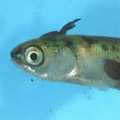 美國一份2日公佈的最新研究報告指出,回游路線經過養殖漁場的野生鮭魚,高達95%會在經過養殖漁場時染上寄生蟲而死亡。報告中針對鮭魚養殖場所面臨的環境衝擊提出嚴峻的警告,研究人員表示,若想維護野生魚群數量,就必須改變養殖漁場營運方式。
美國一份2日公佈的最新研究報告指出,回游路線經過養殖漁場的野生鮭魚,高達95%會在經過養殖漁場時染上寄生蟲而死亡。報告中針對鮭魚養殖場所面臨的環境衝擊提出嚴峻的警告,研究人員表示,若想維護野生魚群數量,就必須改變養殖漁場營運方式。
此報告共同作者,也是亞伯達(Alberta)大學的數學家兼生物學家馬克.路易斯博士說:「我們經常擔心野生動物會把疾病傳染給人類,但這卻是人類使野生動物染病的例子。」
研究發現,養殖漁場的存在,使得幼鮭魚回游至海洋時染上更多魚蝨。魚蝨以魚肉及其組織為食物來源,他們通常以成年鮭魚為宿主,兩者可以共存,但是年幼的鮭魚卻極易因寄生蟲而死亡。
研究員在幼鮭上發現令人震驚的結果,幼鮭的死亡率在早春僅9%,這時魚蝨數量較少;而晚春時魚蝨數量較高時,死亡率則上升至95%。此研究的結果發表在《國家科學院期刊》上。
研究團隊沿著加拿大卑詩省沿海,野生鮭會經過開放式養殖鮭漁場的37英里路徑,計算了超過1萬4000隻野生幼鮭身上的魚蝨數量,並進行3000隻鮭魚的死亡率實驗。
正在攻讀亞伯達大學生物數學博士,也是主要作者的高塞克(Krkosek)表示:「我們使用數學模式來結合資訊,以及評估養殖漁場的整體影響,這也是第一個結合野外調查、實驗及模式來估計養殖漁場整體影響的研究。」
這個研究對於已經因為過度捕撈及棲地惡化而日漸減少的野生鮭魚,勾畫了更另人擔憂的未來。研究人員建議鮭魚養殖漁場至少應搬離野生鮭的遷移帶,甚至可能的話,在開放水域上禁止設置養殖漁場。
達爾豪西(Dalhousie)大學漁業生物學博士梅爾(Ransom Myers)表示:「這個研究提出了一個問題,我們能否讓原生鮭魚和最近興起的大規模養殖漁業在同一地點共同存在。」
Parasites from fish farms kill as much as 95 percent of young wild salmon that migrate past the facilities, according to a new study released today. The research offers a stark warning about the environmental impact of salmon farms, which the authors say must change their operations if wild fish stocks are to survive.
"We often worry about wildlife making humans sick, but here is a case where humans are making wildlife sick," said study co-author Dr. Mark Lewis, a mathematician and biologist at the University of Alberta.
The researchers found that fish farms are dramatically altering the number of parasitic sea lice the juvenile fish are exposed to as they migrate out to sea.
Sea lice feed on flesh and tissue - they are typically carried by adult salmon, which can survive with the parasites. But juvenile salmon are highly vulnerable to the parasites.
The researchers found shocking impacts on the young wild salmon, with mortality rates rising from 9 percent in early spring when the sea lice population was low to 95 percent in late spring when it was higher. The results of the research have been published in the "Proceedings of the National Academy of Sciences."
The research team counted sea lice on more than 14,000 juvenile wild salmon along a 37-mile migration route that takes the fish past open-net salmon farms off the coast of British Columbia., and conducted mortality experiments on more than 3,000 fish.
"We then used mathematical models to combine this information and estimate the total impact of the farms," said Krkosek, the study's lead author and a PhD candidate at the University of Alberta's Centre for Mathematical Biology. He said the study is the first to combine field surveys, experiments and modeling to estimate the total impact of fish farms.
The study's implications paint a worrying picture for wild salmon, which are already in decline from overfishing and degraded habitat. The researchers suggest that salmon farms at the very least be moved away from migratory corridors and possibly altered to close them off from the open water.
"This study really raises the question of whether we can have native salmon and large scale aquaculture - as it is currently practiced - in the same place," said Dr. Ransom Myers, a fisheries biologist at Dalhousie University.




